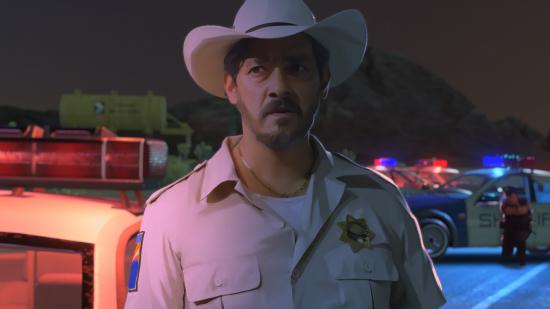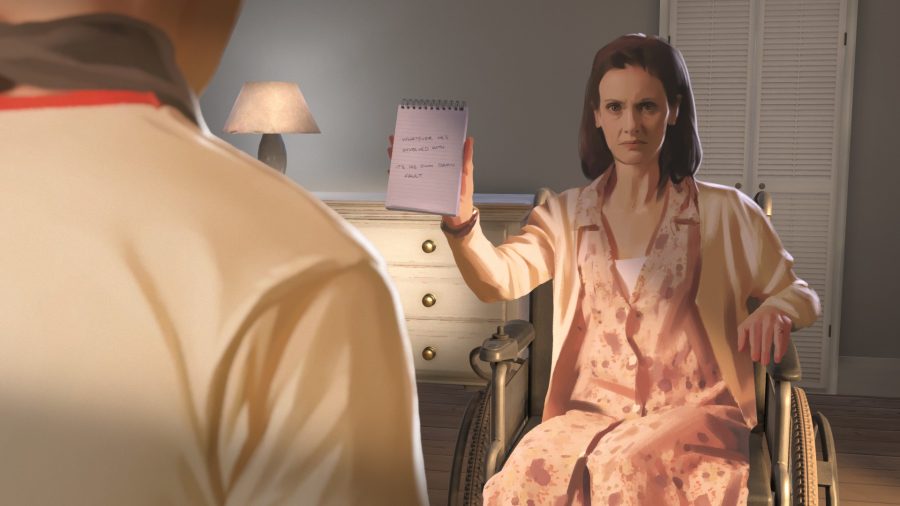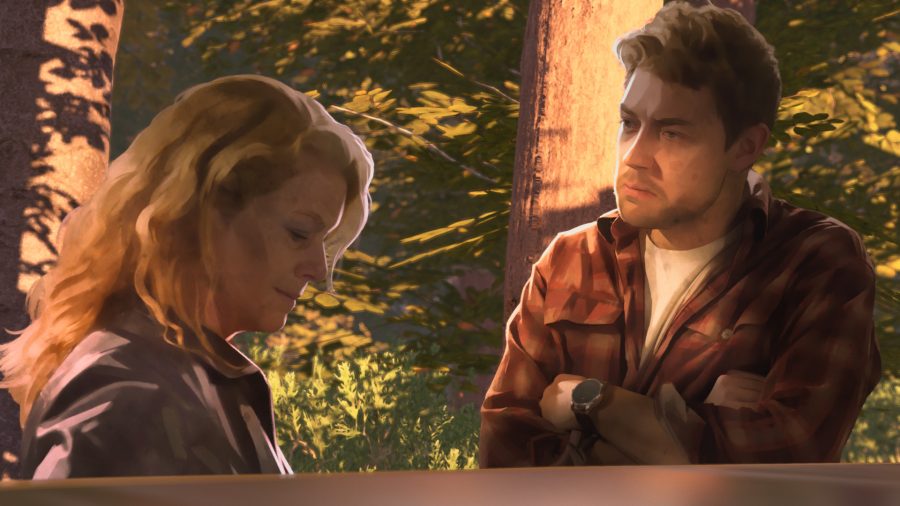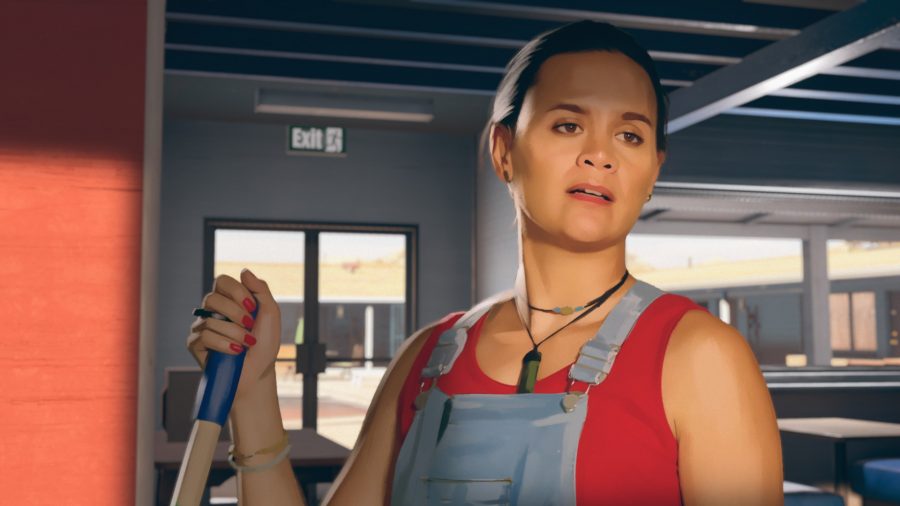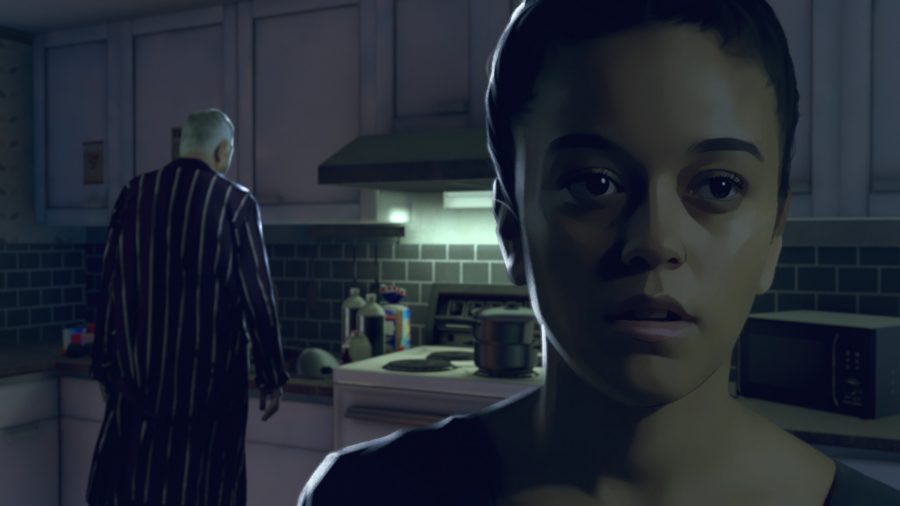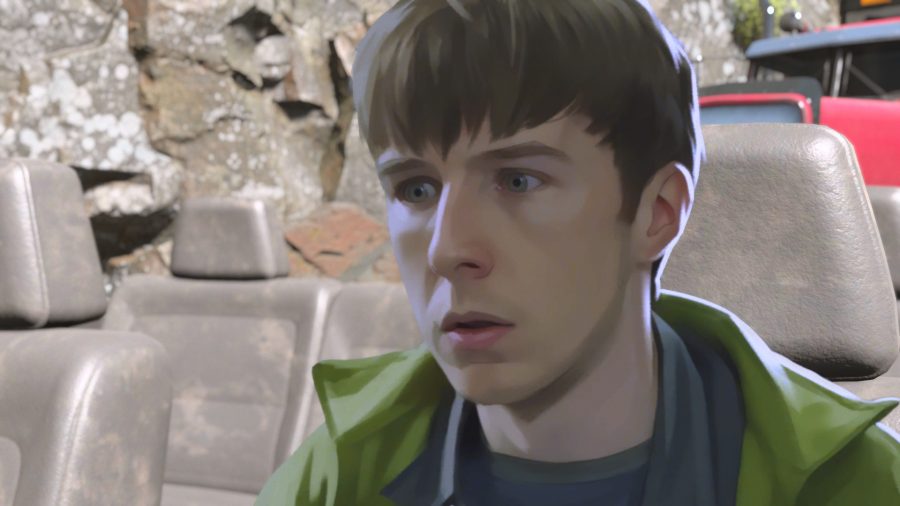It’s been a whirlwind of an adventure for Interior/Night, an independent game studio set up by Quantic Dream and Sony veterans. The company’s first game, As Dusk Falls, has been out in the wild for nearly three weeks now, receiving critical acclaim for the way its story is breaking new ground in the interactive narrative genre.
Whether it’s the mature topics explored by the game’s many branches, its unique art style, or the way in which it brings people together and forces them to think empathetically, As Dusk Falls has quietly become one of the best Xbox Game Pass games to hit the subscription service this year.
But how does a studio publishing its first game cope with that type of success and what does it hope to do next? Well, let’s find out shall we? Here we chat to creative director Caroline Marchal, production director Charu Desodt, and art director Mike Bambury about the development of As Dusk Falls, and what the future holds for a studio that wants to make boundary-pushing narrative experiences.
Congratulations on the release of As Dusk Falls. What’s it like knowing that Interior/Night’s debut game is out in the wild?
Caroline Marchal: It’s been great, honestly. We were a bit nervous, because we didn’t know how the game would be received because it’s so different and unique. It’s been particularly great to see the reception from the core gaming press, but it’s been great to see the reactions from players as well.
Charu Desodt: I really love watching the streamers in particular because we played it as a team. We did a Twitch session during development and it was really fun. So when you see hundreds of people racking up against the different choices, it’s very, very cool.
I’m sure you must have learned a lot about each other playing as a group during the testing period?
CM: Yeah, we have. Charu and I always argue on some of the same choices. When it comes to taking the money in the wallet, Charu always takes it and I’m like, ‘No, you can’t do that – Jay is not like that.’ But she insists.
And there’s the one with peeing in the lemonade, for example, where we always disagree.
Who pees in the lemonade, then?
CD: I do.
CM: I do. But the rest of the team usually doesn’t want to.
CD: Yeah, I think I’ve only played once as a group where they actually wanted to pee in the lemonade…
Fair enough! In terms of the game’s reception has it met your expectations?
CM: It exceeded the expectations on the review side. On the player side, social media isn’t an entirely reliable representation of what the public is thinking but, so far, it’s been so good.
But yeah, seeing the story resonate so well has been fab and the praise for the simple mechanics, approachability and accessibility, the art style is a joy to see, especially in how people are invested in the characters and understand the emotions.
Mike Bambury: I agree. I mean, that was a huge thing because, obviously, we tried something radically new. And we’ve had a terrific response. It’s always been about serving the story and serving the gameplay, and once people play it they get into the story. And that’s what you want, for people to understand the emotions of the characters. And if they’re thinking about the story, then to me, the art has kind of done its job.
And Mike, how did you settle on that art style? It’s obviously very different to other FMVs and other narrative driven games out there.
MB: Quite early on, we realised how important the facial expressions were going to be in delivering a very complex set of nuanced emotions because these are very mature storylines. There’s also a lot of depth to the storylines and an awful lot of choices in the game – I think it’s one every 20 seconds or so.
We made a decision fairly early on that we actually wanted to try using live action because the actors were just producing these incredible facial expressions. We started with more animation and we paired it back, which is not commonly known. It [the game] is a complex thing because you’ve got time slowing down, decisions, and the multiplier of people’s attention in the room. So we found a sweet spot by experimenting.
I think with the actual look of the characters, the ‘every frame a painting’ mantra, that [simplistic art style] is what we wanted to do, but it was a lot of work. It’s been crazy. [We’ve made] more than 15,000 of these paintings and if we’d have known when we started – I mean, who does that? But we’ve got a brilliant team and we created some sample images.
Then the next challenge was standing it up to be a real process where you could do it 15,000 times without driving people crazy or killing the artists.
How long did that process take?
MB: I think we had a skeleton of it quite quickly because the ‘every frame a painting’ thing was a very useful holder for us. You can tell any story through a painting and I think we always knew if we were going to work with live action, we had to stylize the video and photos that we got from it, but I didn’t want the stylization to get in the way of all the different story moments.
Once we knew that it had to be a painting, then the technique was not trying to solve everything in the first five minutes. We kind of got a look that we liked and then we figured out how to do it many times.
What was it like to design scenes based on snapshots and work with that?
CM: Yeah, that’s very interesting. When we started the shoots with still images, we were asking the actors to pose. Then we quickly realised that’s not the best way to get the best performance. So we actually ended up having them perform the scenes, as they would do on stage on camera and then our talented cinematics team would select the emotional beats they needed to make the scene work. Those unique frames were then sent to our 2D team who would hand paint each of them. So it’s kind of a weird process, but we ended up having something more organic on set, with actors performing and saying the lines and everything.
And then from the videos we would do that work with the animation team in 3D, and then integrate those frames in-game afterwards.
MB: The cinematography is sort of kinetic as well because all of our backdrops are full 3D. So they’re all built in a very similar way to how games are built. We did a real deep dive location shoot where we could get some really nice accurate location details.
Integrating the 2D and 3D is fiddly and difficult – you wouldn’t believe the things that caused us trouble, like someone sitting in a convertible car or someone sitting at a table eating food. Bits of them are behind or in front – there are so many problems. But I think the cinematics did a really wonderful job of just keeping the camera moving. And we actually found there was very little that we could imagine that we couldn’t do in the end. It was a really free process – and we’re still learning.
CD: Yeah, for sure we’re still learning. I think one of the fascinating things for me is seeing how they [the team] actually approach the interpretation of the script. We’ve got such a diverse team – we have games veterans, but also very fresh perspectives from people who’ve worked in film and TV or 2D illustration. So taking those broad experiences, and having those be reflected in how the scenes are shot and how the characters are interpreted also meant that we had a pretty unique take on the cinematics of the game.
Out of interest, what was the cast’s reaction to seeing the final product?
CD: We had a launch party for the game last week. And all the actors came, which was really very cool. And I think they’re blown away by how amazing they look in the game.
It’s funny because they walk in and all of us know exactly who they are and every expression and angle intimately. But they walk in as superstars – like the whole team was really, really excited to see the actors in the flesh.
It’d also be quite interesting to find out whether they’ve played the game and what route they’ve taken. In terms of the story, you’ve talked about screening it before to test players and then changing the narrative. I know Zeus had died in a previous edit and then you removed that. Was there any other particular storyline that you drastically changed as a result from the feedback?
CM: We made some rewrites. Yeah, I mean, there was one storyline – I’m not gonna say which one it was because it would be a spoiler – but in chapter five, we changed the ending drastically because I think it got possibly a little too dark at some point. So we reworked it. We also expanded the branching in the final chapter, when Jay is at the National Park. We added a new character later on – and I love this character – the park ranger.
That’s the ending I got!
CM: Oh, yeah, it’s my fave. Because he’s got the dream job of Jay. It’s like it’s Jay if everything went ok in his life. I just love this extra branching.
But yeah, most of the time, what happens is that rewriting is just tweaking the dialogue so that players understand what’s going on. Sometimes if we’re not clear enough, making sure that the agency is fine. Most of the time it’s choice labelling, making sure it’s clear what the options are. But the story arc and the characters haven’t changed – they’ve always been there. It’s like we’ve been living with these families for so long!
That’s kind of nice though, because at least you’ve followed their arcs from start to finish. What would you all say is the biggest challenge making this game and the biggest reward?
CM: The biggest challenge is that it’s so new. Like, we’ve made it new at every level – the gameplay is super approachable. But under the hood, the game is very complex. It’s a very big game, actually, but on the surface, it’s very lean, simple and approachable.
We ditched 3D navigation from the get go, like it was a very conscious design choice and the visual presentation is also very unique. The story is the kind of story you’re not necessarily playing in games very often. So all these things combined shows we’re going in with a bold and different take on what an interactive narrative experience can be.
CD: For me, it’s that bold, ambitious statement of making a narrative game for a mature, broad audience. That covers a lot, you know, that implies a lot. And having an experience that you can play with other people that you love, who maybe aren’t gamers.
So that meant making something that was very intuitive and extremely simple to play, bringing the game to people with that lean multiplayer on your phone. And making it extremely smooth meant that there was a lot of technical complexity. I mean, what narrative game can you have as a single-player and hundreds of players at the same time, where it’s a really great experience, but one where the dynamic changes?
So yeah, I think one of the big wins for me from all of this is actually seeing it come to fruition.
MB: Right? Yeah, for me, it’s this every frame of painting thing, you know, every single one of those individual characters, there’s so much sort of depth to how they’re stylized. And we have to do it over and over again – there’s a crazy number of locations in the game – and to just try and make every frame a painting when the game is so large and it’s a very small team of people making it – it’s maintaining that level of commitment to just make every frame look as good as you can make it throughout the entire experience and to be able to tell a story in such a way that it does it justice.
The joy of it for me was just little things like witnessing people get really heated over the story choices. Or, you know, when people pick up on these incredibly subtle cues that we painted in never knowing if people were going to get it. But the audience is smart, the audience sees things and they understand things. And it’s been lovely to see that reflected back in the reaction.
Yeah, those subtleties just made it feel even more similar to the TV programmes that we love and watch as well, which I know was a really big aim of yours. But I just want to talk about the endings and Jim specifically. Can players actually solve the mystery about him in your two books or is there more to come?
CM: Zoe finding Jim, probably shot – that’s the ending right now and I won’t comment on anything else [laughs].
But you can find clues about him though. So can you get more of an idea of who he is as a person throughout the story?
CM: I guess depending on the branch you take, you know, like whether you have a conversation with him if you decide to have him exchanged in chapter two. What you discuss with him with Zoey later in chapter six can give you a little bit more clues. But it’s still a mystery.
Honestly, we’ve felt like crime detectives here, trying to piece together different clues we’ve all found in our playthroughs.
CM: Yeah? [laughs] I love the theories that are going around. Like you know the one where Jim is Jay’s father – I love it.
Yeah, we both finished it and talked about the scenes we got and the scenes that we didn’t get. Was it hard to manage all those choices?
CM: Yeah, absolutely. It’s the biggest design challenge because the narrative design is massive on this game – we’ve got 1,200 pages of scripts. It’s like the equivalent of ten to 12 films. But the beauty of it is that when you play it, you don’t necessarily realise it because you experience it linearly. And makes sense. And it flows and that’s totally the goal. Because what we want is the players to shape their own journey. And feel satisfying, like they got what they wanted.
We’ve got a small writing team of very talented people, like we have two and a half writers and I just act like a showrunner. So we set the high level beats and then do multiple drafts and outlines – it’s a lot of work. At some point we reached the capacity, the limits of our brains. We’re quite experienced, but even then there’s just only so far you can go.
So what was instrumental were the play tests, just to see all the branches that were never actually seen. Is there anything we can do? Is it worth it? Because you don’t want to create branches for the sake of it – they have to be meaningful. And that means they have to be taken by at least some minority of players. So we did a lot of tweaking with that. And that was just like a great part of really getting this, this breadth of choices. And the intensity of it is relentless.
CD: I see some discussions online about what is the best ending? And it’s so hard to define what the best ending is. Because with some games, you might say, ‘Oh, it’s the one where everyone survives’ but actually, what does that even mean in the context of As Dusk Falls? Because a character might survive, but are they happy? Have they really escaped? Have they resolved their past and everything that has gone on? Or is it actually that there is no best ending? Because like Caroline says it’s your story that you crafted.
Yeah, so I love all those discussions. And there’s only one character that you absolutely cannot save: Dale.
CM: – and Jim, in a way.
I have to ask this now, because you’ve all talked about different endings and the perfect ending. Do you judge players for the decisions that they make?
CM: Oh, no. We wrote really for multiplayer, so we really had to try and adopt different points of views. And I think all of them are valid. When you look at the values and traits you get at the end of each chapter, none of them are judgmental. It’s [all about] what do you value more? Is it love, family, trust, honesty? They’re all good things. Because ultimately, everybody’s trying to do their best and they’re trying to make the best choice that they think is going to work for the character that they’re playing.
So no, I love to see the different reasoning behind choice making. When we went to Tribeca, we sat down and played with people and had really interesting conversations about decisions. And that makes you change perspective, it helps you exercise the empathy skill – like empathy is a muscle. So having these characters in the game that you make decisions for helps exercise and change your PoV and perspective on the world.
And seeing all these different brains, making decisions on the internet, or in real life is just so exciting.
Now that I/N has its first game published on Xbox Game Pass, what does the future hold? And will you remain an Xbox specific studio?
CM: Well right now it’s a bit difficult to answer that, because we’re still really focused on As Dusk Falls. But what I can tell you is that we’re a narrative studio and we’re going to keep making narrative games that push the boundaries of the medium and really try to attract more people into games. We’re all storytellers in the studio, and we love what we’re making. So we’re gonna keep doing that.
I understand as a studio that there’s a lot of experience working with things like AR and VR. Is there a desire to maybe bring that – and new innovative controllers – to Interior/Night at any point in the future?
CD: That would be incredible. Picking up on what Caroline was saying about innovating within the narrative game space is what it’s all about. We always start with the script and the story and then we create. And this is part of my challenge – we create around the best way to tell that story, the pipelines, and the team that we need. So yeah, depending on what Caroline writes, then I’m up for the challenge.
Additional reporting by Joe Apsey.
